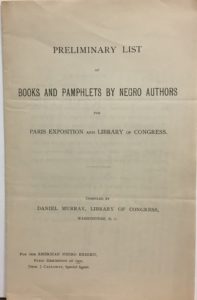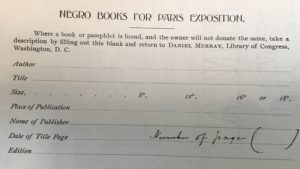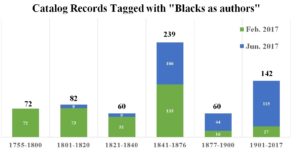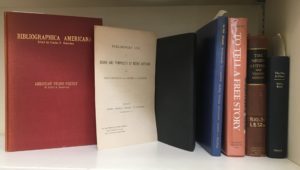Recent conversations addressing the lacuna of representation of people of color in the bibliographic record have ignited a flurry of activity in our cataloging department that we hope users of our catalog will find helpful. As is often the case when we reflect on our cataloging processes and procedures, this activity has a long history here at AAS. In the 1990s and in response to scholars’ needs (most notably those of AAS Librarian Nancy Burkett, Randall Burkett, and Henry Louis Gates, the co-editors of Black Biography, 1790-1950: A Cumulative Index), the question was posed: is there a way to identify works by black authors in the AAS Catalog? AAS Head of Cataloging Alan Degutis reported that there was not, but that there could be, and he, in consultation with his staff, set to work devising a cataloging policy. Henceforth, AAS catalogers began adding to the MAchine Readable Catalog (MARC) records they created the following locally-defined subject headings: “Blacks as authors,” “Blacks in the printing and publishing trades,” and “Blacks as illustrators.” This work was begun in the 1990s, and all rare-book-level records created thereafter include these headings when appropriate.
But what about all of the MARC records that had been created before 1990 and the retrospective conversion records added to the catalog in the 1990s? How could we most efficiently and effectively add these headings to older records? In other words, what could we do to ensure that a user searching for black authors, illustrators, and people in the printing trades could be found in the early American bibliographic record that AAS has been dedicated to producing for centuries? To address this question, we did what we often do when faced with a bibliographic dilemma: we consulted our collections. On our reading room reference shelves, we identified some forty books and pamphlets that might help us identify the names of black people in our catalog and the works of those we might add to the North American Imprints Program (NAIP) records. (For more on NAIP, please see my previous post “Big Data in Early America.”)
The earliest of these is Daniel Alexander Payne Murray and Wilberforce Eames’ Preliminary List of Books and Pamphlets by Negro Authors for Paris Exposition and Library of Congress (1900).
 This eight-page list was sent to libraries in an effort t to collect more “books and pamphlets by Negro authors” for both the Exhibit of Negro Authorship at the Paris Exposition of 1900 and for the Library of Congress collection.
This eight-page list was sent to libraries in an effort t to collect more “books and pamphlets by Negro authors” for both the Exhibit of Negro Authorship at the Paris Exposition of 1900 and for the Library of Congress collection.
 With the blank form they inserted, Murray and Eames asked for reader responses: “[a]ny person able to furnish books or pamphlets on this list, or having knowledge of such as are not on this list” should fill out the card and return it to the Library of Congress. The feedback “will greatly aid this effort … to make certain that all books or pamphlets are duly represented in the collection.” This pamphlet and the responses the blank generated surely deserve further scrutiny, but for now, I point it out as one of the many bibliographic treasures we encountered on our shelves. Ultimately, we identified eight references that would be most useful to help us identify the catalog records to which we could add “Blacks as authors.” This is our starting focus; though we are always looking out for “Blacks in the printing and publishing trades” and “Blacks as illustrators” mentioned in these works, we have not yet made those headings our focus. These references we used (with a brief description of them) include:
With the blank form they inserted, Murray and Eames asked for reader responses: “[a]ny person able to furnish books or pamphlets on this list, or having knowledge of such as are not on this list” should fill out the card and return it to the Library of Congress. The feedback “will greatly aid this effort … to make certain that all books or pamphlets are duly represented in the collection.” This pamphlet and the responses the blank generated surely deserve further scrutiny, but for now, I point it out as one of the many bibliographic treasures we encountered on our shelves. Ultimately, we identified eight references that would be most useful to help us identify the catalog records to which we could add “Blacks as authors.” This is our starting focus; though we are always looking out for “Blacks in the printing and publishing trades” and “Blacks as illustrators” mentioned in these works, we have not yet made those headings our focus. These references we used (with a brief description of them) include:
- Daniel Alexander Payne Murray and Wilberforce Eames, Preliminary List of Books and Pamphlets by Negro Authors for Paris Exposition and Library of Congress (1900), as mentioned above.
- Arthur Alfonso Schomburg, A Bibliographical Checklist of American Negro Poetry (1916) lists imprints by authors (though no dates are given) and includes, at the end, Charles Heartman’s bibliography of Phillis Wheatley.
- Vernon Loggins, The Negro Author: His Development in America (1931) that, at the end of 400 pages of prose, includes a “brief record” with holding institutions of imprints and serials by African Americans from 1760-1900.
- Dorothy Porter Wesley, Early American Negro Writings: A Bibliographical Study (1945) is a “checklist” that includes 292 entries for imprints, serials, and manuscripts held at 31 publicly accessible collections, as well as, in the private collections of Arthur B. Spingarn and Dr. Reynold Johnson.
- Dorothy Porter Wesley and Arthur Alfonso Schomburg, North American Negro Poets: A Bibliographical Checklist of Their Writings, 1760-1944 (1945) is an expansion of the Schomburg published in 1916. It does not include foreign titles, but it doubles the number of domestic titles, including books and pamphlets by individual poets, anthologies edited by Negro authors, and a few printed broadsides. It Includes holdings at 25 collections, and though the entries are not numbered, there are about 620 of them.
- William P. French and Geneviève Fabre, Afro-American Poetry and Drama, 1760-1975: A Guide to Information Sources (1979) includes both Afro-American texts in anthologies and single-author publications as well as studies of these works.
- William L. Andrews, To Tell a Free Story: The First Century of Afro-American Autobiography, 1760-1865 (1986) includes an annotated bibliography of Afro-American Autobiography, 1760-1865 (333-342).
- Jean Fagan Yellin’s and Cynthia D. Bond, The Pen Is Ours: A Listing of Writings by and about African-American Women before 1910 with Secondary Bibliography to the Present (1991) includes writings by and about African-American women who produced separately published writings; writings by and about African-American women who had been enslaved and whose stories, either dictated or written, had been published; and writings by and about African-American women whose works appeared in periodicals and collected writings.
We went through these anthologies and made a spreadsheet of all names that might be found in our catalog. We then searched the Library of Congress Name Authority File (LCNAF) for the identified individuals, matching the form (or forms) of a person’s name as given in the bibliographies to a person’s name (or names) as authorized in LCNAF; it is the latter that we use in the catalog. For example, Wesley and Schomburg identify the author of Catoninetales as Hattie Brown, which is the name on the volume’s title page. However, Catoninetales was written by William James Linton under the pseudonym Hattie Brown, and Linton’s name in LCNAF is authorized as “Linton, W. J. (William James), 1812-1897”; it is this name that we needed to search with to find the thirteen records in which Linton is traced. With this new list in hand, we could identify the books and pamphlets written by a black author with catalog records that did not yet include the subject heading “Blacks as authors” and then add it. We made sure that the headings were applied comprehensively to all works by each author. All of this work continues to be in process, but thus far we have added the heading to almost 300 monograph records.

The blue bars in the graph indicate the progress we have made since we began this work in March 2017. It is a start: we have much more to do, especially to identify “Blacks as illustrators” and “Blacks in the printing and publishing trades.” We are currently mining the amazing collection of North American Slaves Narratives in Documenting the American South not only for more headings we might add to existing records and to records we might create, but also for links we can include in our catalog to full text and XML files for these texts. We have a number of other ideas in the works to enhance our catalog in the hopes that it will serve our users better, make these important works more accessible, and ensure that the AAS does its part to combat the further “symbolic annihilation” of people of color in the historical record.
This work has led to some important conversations in Antiquarian Hall about when to apply the term “Blacks as authors.” We do not determine the terminology used; the Library of Congress Subject Authority Cooperative Program (SACO) does that. In 1990, we decided to use “Blacks” rather than “African Americans,” the two possibilities offered by the Library of Congress. For our purposes, “blacks” seems best because it captured not only people of African descent living in “America” but also those living elsewhere and who might be in our catalog. We are now asking: how is a person identified as black? And how does that identification delimit and circumscribe other identities? For the time being, we consider inclusion in the references listed above as reason to add the subject heading “Blacks as authors.” We are eager, however, to be a part of the the current work at the intersection of digital humanities and bibliography that might alter our practice insofar as this work can interrogate the assumptions under which those who compiled these bibliographies worked. Any alterations of our own practice must be considered along with our adherence to cataloging standards that render AAS data interoperable and meaningful in digital environments beyond our own online public access catalog (OPAC). This balance of subject expertise, bibliographic prowess, and data demands are how we at AAS arrive at our practices of everyday cataloging.
Thanks to Head of Cataloging Services Alan Degutis and Project Cataloger Amy Tims for their help with this post.


One thought on “The Practice of Everyday Cataloging: ‘Blacks as authors’ and the Early American Bibliographic Record”